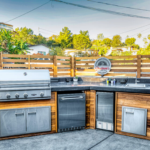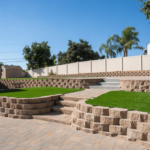Patios are often the hub of outdoor living, providing a space for relaxation, entertainment, and leisure activities. Over time, weather conditions and wear and tear can diminish the appeal and functionality of your patio. Revamping or redoing a patio can breathe new life into your outdoor space, but the cost can vary significantly depending on multiple factors.
Understanding the Variables
The cost of redoing a patio is influenced by various elements, such as:
- Materials: The choice of materials significantly impacts the cost. From concrete and pavers to stone and tiles, the price can fluctuate based on the material’s quality and type.
- Size and Layout: The size and layout of the patio play a crucial role in determining the overall cost. The cost will go up in larger areas since more work and supplies will be needed.
- Labor Costs: The intricacy of the project, the area, and the experts engaged to complete it can all affect labor expenses.
- Additional Features: It will cost more to include extra amenities like built-in seating, fire pits, outdoor kitchens, or landscaping.
Materials and Their Costs
- Concrete: One of the least expensive options is concrete; depending on the style and finish, pricing per square foot can range from $6 to $17.
- Pavers: Pavers are reasonably cheap, with many styles available, around $10 to $20 per square foot. Intricate designs or premium materials may increase the cost.
- Flagstone or Natural Stone: Natural stone like flagstone can be more expensive, averaging around $15 to $30 per square foot due to its durability and aesthetics.
- Brick: Brick starts from $14 and can go up to $30 per square foot. However, it depends on the quality and style you go for.
- Tile or Porcelain: customized tiles cost a lot more than normal tiles. However, porcelain or ceramic tiles can start from $5.
Estimating the Costs
For a small space, a basic patio restoration might start at roughly a couple thousand using moderately priced materials like basic concrete. Projects in the medium tier could cost $5,000 or more and include more opulent materials and extra comforts. Depending on the size and complexity of the project, high-end renovations employing premium materials and innovative ideas can cost up to $15,000.
Factors Influencing Costs
Skill Specialization: Consider hiring professionals with specialized skills in specific areas like masonry, landscaping, or carpentry, which might lead to a higher initial cost but could result in superior quality work, reducing the likelihood of future repairs or replacements.
Permit Handling: Factor in the expenses related to acquiring permits for construction or renovations, as well as any associated inspection fees, which can vary based on the area and the project’s scope.
Waste Disposal: Account for the costs associated with waste removal or dumpster rentals, as the disposal of debris and old materials from the site, might incur additional expenses.
Unforeseen Challenges: Set aside a contingency budget to address unexpected issues or complications that may arise during the renovation process, allowing for flexibility in case of unanticipated costs.
Equipment Rental: If undertaking a DIY approach, calculate the expenses for renting specialized tools or equipment required for the project, which can add to the overall renovation costs.
Transportation and Delivery: Factor in the costs of transporting materials and items to the site, considering delivery fees or potential surcharges based on the distance or quantity of materials needed.
Insurance and Liability: Consider the necessity of insurance coverage or warranties for the renovation project, protecting against unforeseen damages or liabilities, potentially adding to the overall expenses.
Site Preparation: Assess the expenses related to site preparation, including grading, leveling, or addressing drainage issues, which are crucial for a successful patio renovation.
Quality Assurance: Invest in quality materials and skilled labor to ensure a durable and long-lasting patio, reducing future maintenance or replacement costs in the long run
Cost-Saving Strategies
Collaborative Projects: Consider enlisting the help of friends or family members who possess relevant skills, contributing to a joint effort to lower labor costs.
Upcycling and Repurposing: Explore options to repurpose existing materials or furniture. Therefore, giving them a new life within the revamped patio design, and reducing the need for entirely new purchases.
Comparative Analysis: Research and compare prices from different suppliers to find the best deals on materials. Therefore, ensuring cost-effectiveness without compromising quality.
Seasonal Timing: Plan the renovation during off-peak seasons when contractors might offer discounts or when material prices are lower.
Multifunctional Features: Opt for multifunctional patio elements that serve dual purposes. For example, benches with built-in storage or tables that can convert to fire pits, maximizing utility without excessive spending.
Community Resources: Look for community tool-sharing programs or local workshops. Where you can borrow or rent tools and equipment, reducing additional expenses.
Proactive Repairs: Address minor damages promptly and conduct regular inspections to prevent small issues from escalating into larger, costlier problems.
Educational Resources: Explore DIY workshops, online tutorials, or community college classes to gain skills for DIY projects. Therefore you will save on labor costs for simpler tasks.
Long-term Planning: Opt for durable, long-lasting materials and invest in quality. In order to reduce the need for frequent replacements or repairs in the future.
Financial Assistance: Explore financing options or seek advice from professionals for cost-effective financing solutions. So that fits your budget and reduces immediate financial strain.
Maintenance Requirements: Understand the maintenance needs of different materials and select ones that align with your upkeep preferences and capabilities.
Aesthetic Cohesion: Ensure the new patio design complements the overall aesthetic of your home and landscaping for a harmonious look.
Functionality and Purpose: Define the primary purpose of your patio. Decide whether it’s for entertainment, relaxation, or dining, and tailor the design accordingly.
Accessibility and Safety: Consider accessibility for all users and ensure the patio design adheres to safety standards. Especially if children or elderly individuals will frequently use the space.
Environmental Impact: Choose materials and features that align with eco-friendly practices to minimize the environmental footprint of your renovation.
Transformed Outdoor Space
Redoing a patio can enhance the aesthetics, functionality, and value of your property. The cost of such a project varies based on materials, size, additional features, labor, and location. Careful planning, budgeting, and exploring cost-saving strategies can help manage expenses. With the right approach, a revamped patio can transform your outdoor space into a charming retreat for years to come.






